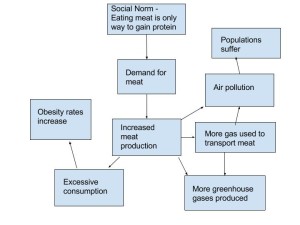1.) In 125-175 words, create an argument to support the preservation of biodiversity through an anthropocentric lens.
The conservation of many natural ecosystems is an important issue facing our society as we know it. Deforestation threatens to alter the landscape and radically change the way we obtain building resources, fossil fuels, and other major aspects of our lives. Our standard of living was heavily influenced by the presence of the biodiverse areas, and without them our way of life will change. Efforts such as urban agriculture attempt to address and mitigate some of these challenges, but these alone are not enough to help maintain the biodiversity that exists throughout the world. Humans enjoy the comforts of live in today’s society because of the natural processes that occur in areas collocated with major population centers. To preserve the Earth as we know it today, Human’s must preserve biodiversity or face a radical change in the way they live.
2.) In 125-175 words, create an argument to support the preservation of biodiversity through an ecocentric lens.
Since the beginning of the Earth’s atmosphere and the first formation of biological life, natural processes and biodiversity have helped prolong the coexistence of all living species. As we are near the top of the food chain in main instances around the world, it is our duty to make sure we preserve biodiversity. Because we are conscience of the consequences, it becomes a question of ethics whether or not we should take collective active to attack the threats on biodiversity. While some are natural causes, most are anthropogenically caused threats, and these we can take a stand on to help end current problems like deforestation, overhunting, overgrazing, invasive agriculture, etc.. The fates of many ecosystems around the world rely on the action that we humans take going forward. Development should be considered in this, especially in many third world countries, as the development that takes place will be the new generation of development and must set an example for other budding countries.
3.) If you were to go to Congress or your state government, or any large scale policy making institution, which argument would you choose to use? Why? Would this change based on your location globally (i.e., would your argument change from country to country) or would it remain consistent regardless of where you are? Why do you think this is?
When taking this issue to a larger political body, such as Congress, I believe it is most effective to use the anthropocentric lens rather than an ecocentric lens. The reasons behind this are somewhat obvious, but stem from the fact that humans nowadays are extremely selfish. This attitude may be no different than before, however, the difference today is that we have the manpower and machinery to cause massive devastation to ecosystems, whereas previously we did not. I think globally, this does not change very much either. Many budding countries are looked after by either powerful countries or corrupt countries. The countries that America supports must take an anthropocentric approach when approaching future development, as Congress and the people who control the policies that are made are not all too concerned with the effects that development can have on biodiversity. I think humans who are in charge of countries see most life on this planet as lesser than humans, and therefore do not consider the consequences.


